The widest part of my hips reaches approximately 50 inches, while my waist is only about 25 inches wide. I know my shape looks just like the sort of authentic American woman’s body type that the men here love.
Sounds great, but that’s why I’ve always struggled with having some gaps between my jeans and my back (perhaps for my entire life).
This stuff sort of puts me in a situation where I always have to lift the waistband of my jeans every 10 minutes while moving my body, in case I forget to seal the gaps with the belt on.
I know it sounds like no elegance at all. But having space in your back when wearing jeans is more awkward than you think.
These actions are a real disaster for either the professional workplace or even in casual coffee or meetings with friends.
Since jeans are about to stretch every time we wear them, things often get worse by putting on jeans with such large gaps all day long.
Here is why and how to fix the problem.
Quick Navigation
Why do my jeans always gap in the back?
Gaps happened between your back and the jean’s waistband for many reasons.
Sagging waistband

Jeans are woven mostly from cotton denim fabric. These natural fibers are mainly produced from cotton plants.
As a plant-based material, cotton jeans are more prone to shrinkage when exposed to water or high temperatures. The higher the temperature, the greater the shrinkage.
Therefore, the stretch of 100% cotton jeans only occurs at a pretty low level since they tend to constrict when washed.
But this is no longer true of stretchy jeans, which have a much lower percent of cotton than cotton jeans when combined with Spandex, polyester or Lycra. The lower the cotton content, the lower the degree of shrinkage when it comes to jeans.
Stretchy jeans often stretch greatly as you wear them over time. Low-rise or mid-rise stretchy jeans tend to put more pressure on the waistband when the pants sag. That’s why there’s a huge gap in your back, especially when you’re sitting down.
Sure, you’d never look neat enough in these jeans.
Big Butt

This is a problem that I often run into when it comes to wearing jeans, as I mentioned at the beginning of this article.
The huge difference between butt and waist size will always, always trigger your perfect satisfaction when wearing jeans. That’s because most jeans manufacturers don’t rely on these different measurements to build their pants.
This works just fine for normal people, but not for those who have an extra large buttstock like us. That’s why we have to size up the jeans just to fit the butt’s measurements.
But at the same time, the pants will never fit perfectly around the waist. I’m not even the right height for sized-up jeans.
Therefore, I often have to adjust the hem and the waistband all the way out.
Anyway, this won’t stop us from continuing to wear jeans. So stay away from skinny jeans or straight-legged jeans. Boyfriend jeans are our best friends.
These jeans fit just fine around the hips, but there’s a more relaxed and generous fit around the buttstock and legs.
Loose jeans
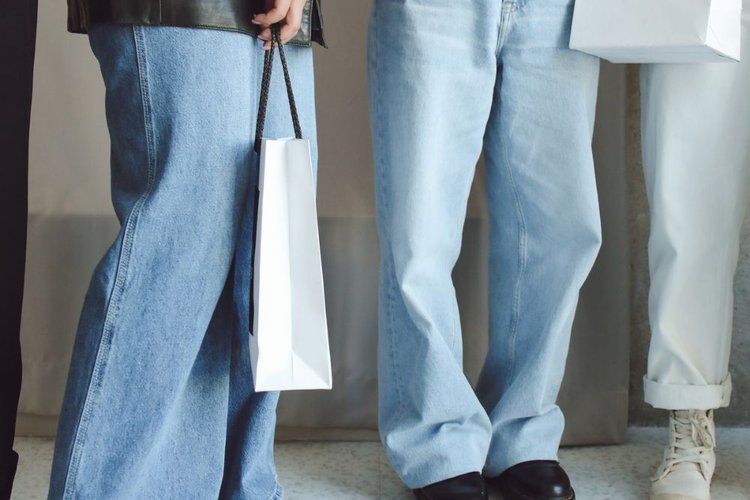
Loose jeans are on their way to making a comeback in our street wear. They are truly the most comfortable pants I have ever worn. These designs have no tapering from the thigh down to the hem. Sometimes they look like a pair of hippie pants made of jeans.
Due to this extra relaxed fit, loose jeans are usually made of 100% cotton or very little Spandex or Lycra in the structure of the fabric.
For that reason, loose jeans should not be embraced from the waist down to the ankles perfectly. The waistband is usually stiff, wide and often reaches above the waist.
If you don’t close this space with a belt, it will create some gaps between the waist and the waistband of the pants.
Besides, the loose design from top to bottom will never fit the body’s curves perfectly, especially for women’s shape. But this is what the wearer loves about this design.
Extra high rise jeans

Extra high-rise jeans often come with a waistband design that reaches above the navel. This allows the wearer to comfortably coordinate with the crop top without appearing too sexy or seductive.
However, I bet 90% of women who wear extra high-rise jeans will never feel the waistband fit their waist tight enough that it won’t create any space in the back, even when they are wearing super stretchy jeans.
This is because the waistband of the jeans will likely touch the smallest point of the waist.
And there are almost no mass-produced jeans designs that can fit everyone in this size.
It can be a little tight for a fatty waist, but it can be too wide for a slender shape as well.
Oversized jeans

Right, oversized jeans always mean there’s lots of space from top to bottom when it comes to wearing them. The wide waistband is no exception. You probably won’t feel this too obvious in skinny jeans, even if you go up 2 sizes.
However, oversized bootcut jeans, baggy jeans, or straight-leg jeans all result in gaps between the wearer’s waist and the jeans. A belt might be just what you need.
Stretchy waistband

Jeans waistbands are usually made from denim fabrics. But not all cases are the same. Some comfortable jeans designs use elastic or stretchy fabric to sew the waistband. Unlike cotton jeans, fabrics are generally not likely to shrink after washing.
As a result, they will continue to stretch and expand over time, especially if you machine wash them.
This is why, after a few months of regular use, you will find these pants keep falling down after a few steps, making you always have to pay attention to the waistband.
You lost some pounds?!

Your jeans are fine and they still fit your curves well right out of the bag so far. One day, you decide to wear these jeans again that you have had at the bottom of your closet for a long time.
They became really too wide and there was a big gap in the back. You’ve probably lost a few pounds (or quite a few pounds). This will result in the jeans becoming oversized for you and not fitting your hips and waist perfectly.
Men’s jeans
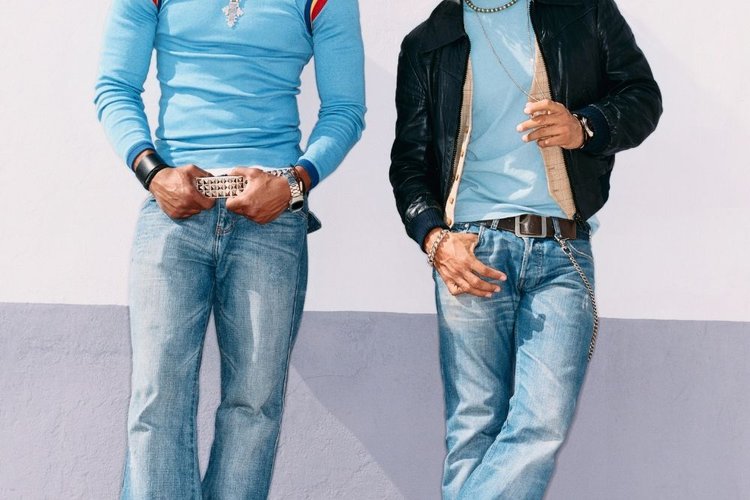
Aside from skinny jeans for men, most men’s jeans have a rather wide waistband design compared to the design of women’s jeans. This may come from the fact that most men often prefer loose jeans instead of snugly fitting ones like women do.
In addition, men also put on belts when wearing pants much more often than women. All of these enabled more spacious jeans designs for men.
How to fix gaps in the back when wearing jeans?
The good news is that all of these problems are able to be controlled. Here’s how.
Go with any kind of belt
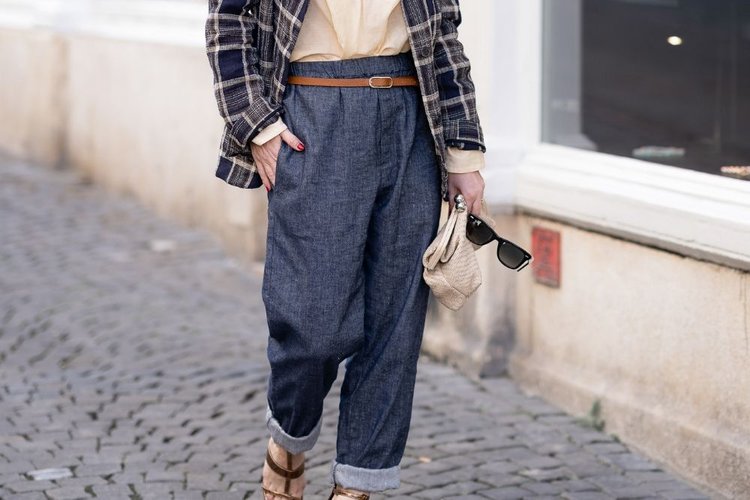
The simplest way we all use when jeans are loose with gaps between the waist and pants is to tighten these spaces with a belt.
Men can choose large leather belts, while women will prefer smaller and more sophisticated designs.
But the condition for doing this is that your jeans must come with belt loops. Otherwise, the belt will not work effectively.
You can still tighten the waistband with a belt without belt loops, but the device won’t stay firmly in place, and your outfits will inevitably fall apart.
Ladies, if you feel the leather belt is too stiff and sort of breathless, the string belt will be another interesting option for you. They are shaped like large parachute cords.
The important thing is that they are thinner than leather belts and have a high degree of flexibility. They allow the wearer to loosen up easily without any inconvenience.
Go tailor
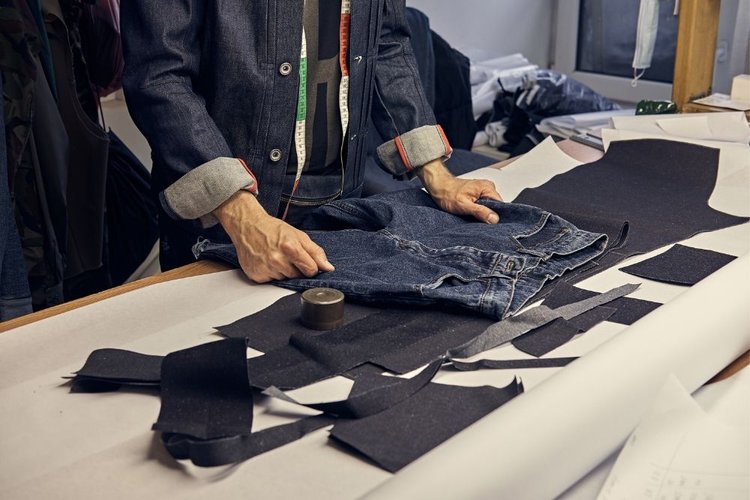
If you prefer some sustainable solution to this problem, tailoring your jeans is the best way. You will probably need to see your local tailor and ask them if there is a way to permanently shrink the waistband of your jeans.
From my own experience, some tailors won’t be too happy when you come to see them. This is due to the fact that the seam structure of jeans is quite a bit more complicated, denser, and more overlapping than the usual chino, khaki, or dress pants.
To shrink the jeans’ waistband, they’ll likely need to take the stitches apart from top to bottom and sew them back up afterwards. This is almost like when they sew a new pair of jeans out of old jeans.
Does it sound pretty laborious?
So, if someone agrees to help you shrink jeans this way, don’t be afraid to hand them a couple more bucks, especially if your jeans are worth a few hundred dollars. After all, it’s all worth it.
Sewn the gaps with an elastic wire
Here’s one of the best DIY ways to fix the gaps in the back when it comes to wearing oversize jeans. By attaching an elastic to the inside of the waistband where it comes into contact with your back, these gaps can be significantly eliminated. You can even adjust the width of the gaps in this way. You need to have:
- 1 Scissors
- Needle for hand sewing
- 1 elastic with 1 hole-aligned band
- A button
You need to cut 2 symmetrical holes through the pants tag. Pay attention to the length of the elastic to locate the best 2 holes. The elastic should be 2 inches longer than the distance between the holes.
Based on the fact that a jeans’ waistband is hollow on the inside, you need to thread the elastic through the waistband.
Then you need to secure one end of the elastic in one hole with strong stitches with a needle and thread.
On the other hole, sew the button right beside the hole firmly. You don’t need to sew the elastic to the needle here. Because you need to adjust the width of the gaps by fitting the button to each hole on the elastic.
It’s all done now. Let’s see if it works for you.
Shrink the waistband
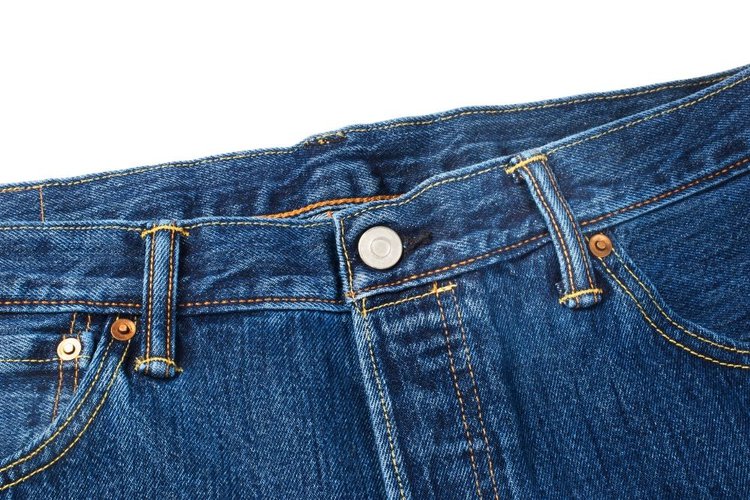
If the gaps between the waistband and the back are relatively small, you can simply find a way to shrink the material instead of fixing some spots here with a needle and thread.
The best way is to use the temperature since most jeans are likely to shrink well with high heat. Keep in mind that this may not work with low-cotton content jeans.
You need to prepare 1 pot of hot water, maybe boiling water.
Then, you dip only the waistband of the jeans in a basin of water for 1 minute. If your jeans are dark in color, you may need to turn them inside out before exposing them to hot water.
You will probably need to repeat the process a few times. However, you should not leave jeans in hot water for too long. The fabric will shrink strongly.
After that, you need to squeeze out the water that has collected in the waistband.
Use air drying with clothes pegs when drying instead of hangers since hangers tend to somewhat stretch the waistband to some extent.
Emergency hacks
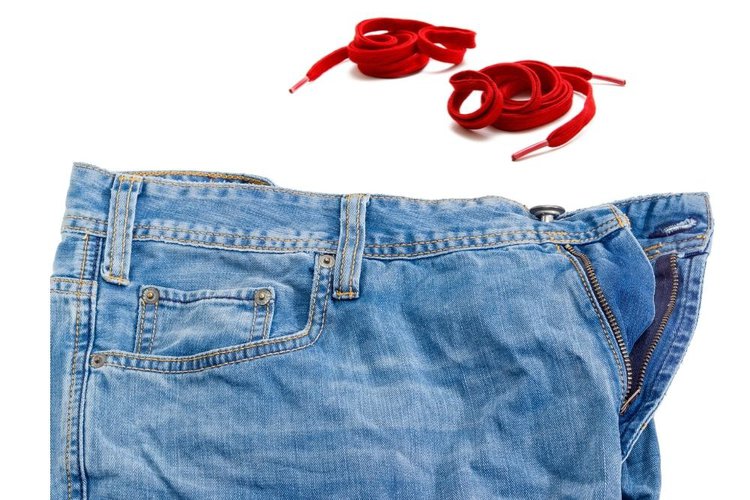
In some cases, an urgent way to fix this problem is to use shoelaces to increase the fit of the jeans on the wearer’s body.
All you need is a shoelace, no matter the color. You thread the shoelaces into two symmetrical belt loops across your back. Then you knot the rope behind your back. Keep in mind that the jeans should cover the shoelaces and the knot.
Go for either jeans with drawstring or elastic waistband
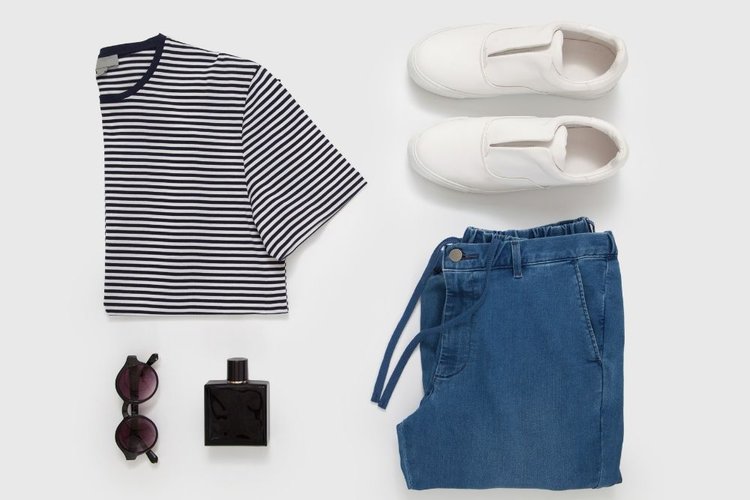
Finally, to prevent your jeans from sagging after a period of regular use and machine washing, you can choose jeans with a drawstring or elastic waistband instead of a regular jeans waistband from the beginning.
These designs are attached with a drawstring across the waistband, allowing the wearer to customize the fit in this area effortlessly.
You won’t be bothered with sagging jeans with lots of gaps in the back. However, these designs may not look as sophisticated and elegant as regular jeans.
They are often used as part of sportswear or home wear rather than for formal purposes.
Before you leave…
It’s not a great experience when wearing jeans with lots of gaps in the back. It shows your outfits do not work properly. No matter what you do, your confidence is no longer in the highest mode. I hope you find some good solutions that work for you in this article.
Hi, I’m Grace Alision, a fashion lover with a passion for helping women feel confident and beautiful through their style choices. I created this website to share my love for wedding guest dresses and, in the future, to explore concert outfit inspiration. Dresses have always been my favorite way to express elegance and individuality, and I’m here to make finding the perfect outfit fun and easy. When I’m not working on outfit ideas, I love discovering new trends and connecting with others who share my love for fashion.

